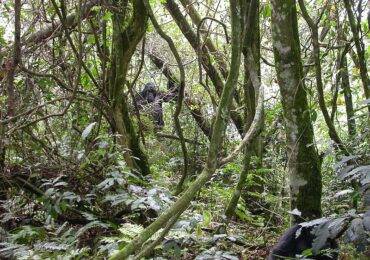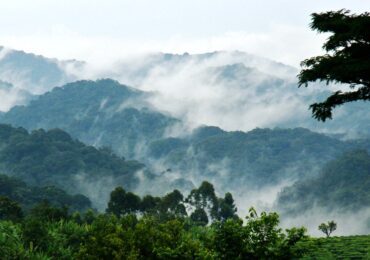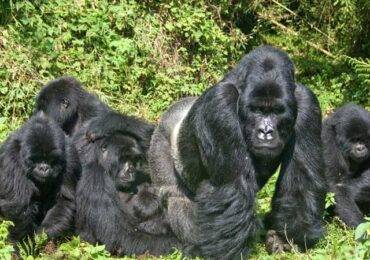 In 1932, two blocks of the Bwindi Impenetrable Forest were designated as Crown Forest Reserves. The northern block was designated as the “Kayonza Crown Forest Reserve”, and the southern block designated as the “Kasatora Crown Forest Reserve”. These reserves had a combined area of 207 square kilometres (80 sq mi). In 1942, the two reserves were combined and enlarged, then renamed as the Impenetrable Central Crown Forest. This new protected area covered 298 square kilometres (115 sq mi) and was under the joint control of the Ugandan government’s game and forest departments.
In 1932, two blocks of the Bwindi Impenetrable Forest were designated as Crown Forest Reserves. The northern block was designated as the “Kayonza Crown Forest Reserve”, and the southern block designated as the “Kasatora Crown Forest Reserve”. These reserves had a combined area of 207 square kilometres (80 sq mi). In 1942, the two reserves were combined and enlarged, then renamed as the Impenetrable Central Crown Forest. This new protected area covered 298 square kilometres (115 sq mi) and was under the joint control of the Ugandan government’s game and forest departments.
In 1964, the reserve was designated as an animal sanctuary to provide extra protection for its mountain gorillas and renamed the Impenetrable Central Forest Reserve. In 1966, two other forest reserves became part of the main reserve, increasing its area to almost 321 square kilometres (124 sq mi). The park continued to be managed as both a game sanctuary and forest reserve.
 In 1991, the Impenetrable Central Forest Reserve, along with the Mgahinga Gorilla Reserve and the Rwenzori Mountains Reserve, was designated as a national park and renamed the Bwindi Impenetrable National Park. It covered an area of 330.8 square kilometres (127.7 sq mi). The national park was declared in part to protect a range of species within it, most notably the mountain gorilla. The reclassification of the park had a large impact on the Batwa pygmy people, who were evicted from the forest and no longer permitted to enter the park or access its resources. Gorilla tracking became a tourist activity in April 1993, and the park became a popular tourist destination. In 1994, a 10-square-kilometre (3.9 sq mi) area was incorporated into the park and it was inscribed on the World Heritage List. The park’s management changed: Uganda National Parks, since renamed the Uganda Wildlife Authority, became responsible for the park. In 2003 a piece of land next to the park with an area of 4.2 square kilometres (1.6 sq mi) was purchased and incorporated into the park.
In 1991, the Impenetrable Central Forest Reserve, along with the Mgahinga Gorilla Reserve and the Rwenzori Mountains Reserve, was designated as a national park and renamed the Bwindi Impenetrable National Park. It covered an area of 330.8 square kilometres (127.7 sq mi). The national park was declared in part to protect a range of species within it, most notably the mountain gorilla. The reclassification of the park had a large impact on the Batwa pygmy people, who were evicted from the forest and no longer permitted to enter the park or access its resources. Gorilla tracking became a tourist activity in April 1993, and the park became a popular tourist destination. In 1994, a 10-square-kilometre (3.9 sq mi) area was incorporated into the park and it was inscribed on the World Heritage List. The park’s management changed: Uganda National Parks, since renamed the Uganda Wildlife Authority, became responsible for the park. In 2003 a piece of land next to the park with an area of 4.2 square kilometres (1.6 sq mi) was purchased and incorporated into the park.

 Bwindi was gazetted as a National Park in 1991 and declared a UNESCO Natural World Heritage Site in 1994. Its mist-covered hillsides are blanketed by one of Uganda’s oldest and most biologically diverse rainforests, which dates back over 25,000 years and contains almost 400 species of plants. More famously, this “impenetrable forest” also protects an estimated 400 mountain gorillas – roughly half of the world’s population, including several habituated groups, which can be tracked.
Bwindi was gazetted as a National Park in 1991 and declared a UNESCO Natural World Heritage Site in 1994. Its mist-covered hillsides are blanketed by one of Uganda’s oldest and most biologically diverse rainforests, which dates back over 25,000 years and contains almost 400 species of plants. More famously, this “impenetrable forest” also protects an estimated 400 mountain gorillas – roughly half of the world’s population, including several habituated groups, which can be tracked.
